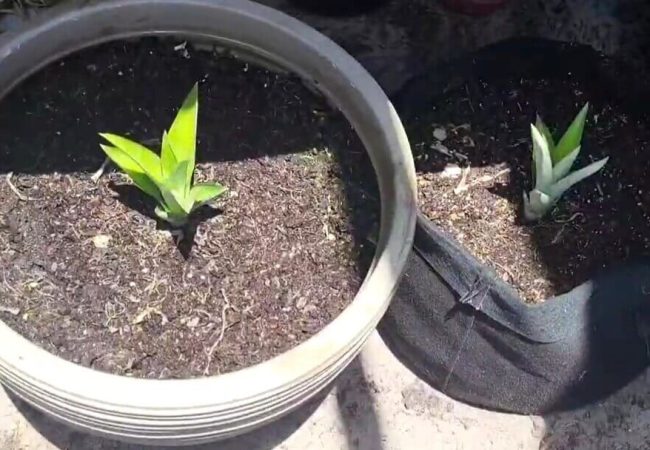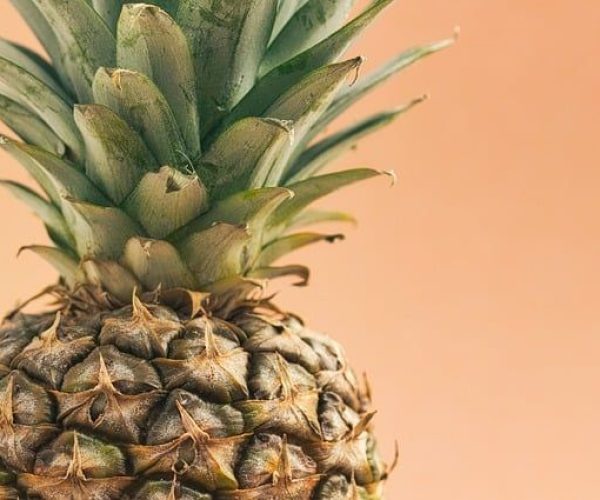Wondering how to easily propagate pineapple plants for higher yields? You’ve come to the right place! In this post I will demonstrate how to propagate pineapple plants from pups, or suckers. Additionally, I’ll list other ways you can multiply your pineapple plants.

What is Pineapple Plant Propagation?
Pineapple plant propagation is the process of creating new pineapple plants from existing ones. There are different ways to approach this. In this post I’m demonstrating how to easily propagate pineapple plants from pups or suckers. However, I will also touch on some other ways of doing so.

The Basics of Pineapple Plant Growth
Each pineapple plant’s growth begins with a rosette of leaves at the base. As they continue to grow and the plant matures, it will develop a stalk that will bear its only fruit. After it produces fruit, it will focus on making side shoots called pups or suckers (also called ratoons). However, these pups or suckers can form well before the plant sets any fruit.
This is what happened with all of my pineapple plants. The pups can be used to start new plants, which grow quicker and set fruit faster than if you were to grow pineapple from the crowns (the leafy tops).
Propagating Pineapple Plants from Pups or Suckers
As you can see in the photo below, I had a struggling mother pineapple plant that started dying after a couple nights of frost here in Florida, but during this process it sprouted three pups. Whether you have a struggling mother plant like I did, or a completely healthy one, when they form pups like these you generally want to remove them so they can all grow individually.
Reason being, if you grow them individually you’ll end up with larger pineapple fruits. If you leave the pups on the plant, they will grow together just fine, but will likely form smaller fruits. I ended up cutting the mother plant’s dead leaves down to the base, and removing two of the three pups.

Should I Place My Pineapple Pups in Water or Soil?
A lot of times people will place the base of the pups in a glass of water first to develop roots before planting. Although this is effective, so is planting them directly in the soil.
The pros of placing pups directly in soil are: first, you eliminate the step of growing roots in water before planting. Second, the success rates of rooting in soil are higher than in water.
The cons are: if it’s windy outside the pups will have to be staked so they don’t tip over. Additionally, you’d need to make sure the soil stays damp so the roots don’t dry out. However, this is only temporary until the pineapple plant establishes some of its roots.

How to Remove and Plant Pineapple Pups
First, grasp the base of the pup and gently twist to remove it.
I left one pup attached to the mother pineapple plant because the mother had stopped growing, therefore the pup would take advantage of the already-established root system. You can see where I’m pointing to it in photo number 4 below.
Before you do this, though, make sure the pups are at least 4 inches tall. Anything smaller than that will have a low success rate of rooting.

Next, add soil to your containers, and water.
Let me first emphasize that you can certainly grow pineapple plants in-ground; however, I’ve always grown mine in containers. This is because the soil here in Florida is generally very sandy and depleted of nutrients, so I’d have to first amend the soil and keep on top of it throughout the plant’s lifecycle.
For me, it’s just easier to grow pineapple plants in pots or containers. Ideally, the best pot or container size for pineapple plants is around 5 gallons. Furthermore, these plants thrive in sandy, loamy soil that is rich in organic matter. A cactus, palm, or citrus potting mix will do, and you should mix compost into it for nutrients.
Additionally, you can remove the bottom set of leaves like I did in photo number 5 below, but this is not actually necessary. Now, water the soil and plant the pup about 1/2 – 1 inch deep.

Finally, place pots in a shady location with indirect sunlight.
Too much direct sun can dry out the soil quicker and burn the developing roots. Leave the newly-planted pineapple pups in a shady location until they start forming roots and are set in the soil.
An hour or two of direct sunlight per day should be sufficient until their roots are well developed. See how you can easily propagate pineapple plants now?

How to Propagate Pineapple from Tops or Crowns
Propagating pineapple plants from tops is super easy. For example, I first started growing pineapple after bringing home a pineapple fruit from the store. This was right after I learned you can twist off the leafy top (the crown) and plant it. After some quick research, I prepared my pineapple top for planting.
Notably, this is yet another way to propagate, or multiply, your pineapple plants, assuming you already have fruiting pineapple plants and are using the fruit’s tops to grow more plants. Simply purchase a pineapple from the store and twist off the top.
Next, remove a few layers of the lower leaves to expose the roots (they’ll look like flattened worms haha). You can leave it out to dry for a couple of days to prevent rot, but I never did and mine never rotted. Finally, place the base of the pineapple top directly into well-draining soil.

A Hack on Propagating Pineapple Tops or Crowns
Although I’ve never tried it, some folks in my YouTube community have, and their advice is to twist off the top and then cut it vertically into 4 pieces. Leave them on your counter to dry for a few days, and then plant them. It requires a sharp knife and some patience, but you’ll get 4 pineapple plants from just one top!
Benefits of Propagating Pineapple Plants
Faster growth and quicker harvest time than growing from seeds, tops, or crowns.
Money saving, as you’ll be able to multiply your pineapple plants without having to purchase seeds or existing plants.
Greater survival rate, because pups or suckers from a healthy mother pineapple plant are stronger and less vulnerable to environmental stressors compared to pineapple plants grown from seeds.
More resilient against pests and diseases.
FAQs
It can take anywhere from 1-2 years to bear fruit. In contrast, growing pineapples from the tops like I did at first can take 2-3 years to form fruit.
Pineapple plants like a loose, well draining loamy type of soil. A cactus, palm, or citrus potting mix will do, and mix compost into it for nutrients.
The best pot or container size for pineapple plants is around 5 gallons, which is approximately 12 inches in diameter and 10-12 inches tall.
Other Posts You Might Like
Final Thoughts
I hope this post demonstrates how you can easily propagate pineapple plants in your own garden. Propagating pineapple plants from pups or suckers is pretty straightforward, and doing so offers several benefits.
For starters, it’s cost-effective, and you get faster growth with higher success rates than growing pineapples from seeds or crowns. Secondly, they grow stronger and are more resilient to pests and diseases. Lastly, propagating pineapple plants from pups is great for home gardeners (like myself), and very easy to do.
By following these steps you can ensure a steady supply of fresh, home-grown pineapples.




